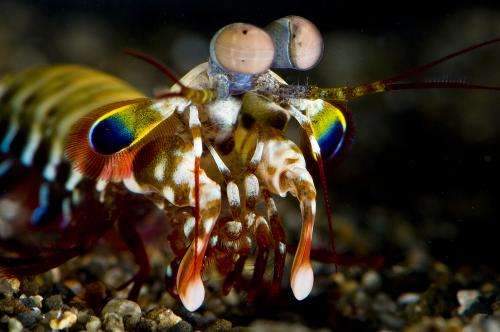January 24, 2014 report
Study finds mantis shrimp process vision differently than other organisms (w/ video)

(Phys.org) —Researchers with the University of Queensland, Brisbane along with an associate from National Cheng Kung University, in China have found what they believe to be a reasonable explanation for mantis shrimp having 12 photoreceptors in their eyes. In their paper published in the journal Science, the team describes a study they conducted where shrimp were trained to respond to different colors, which led to the discovery that despite more receptors than most other organisms, they are less able to discriminate between different colors—a finding that indicates they process colors in a different way. Michael Land and Daniel Osorio offer a Perspective piece on the researchers efforts in the same journal issue.
Scientists have known for many years that mantis shrimp have more photoreceptors than most other organisms, but have not, until now, been able to come up with a reason why. The assumption had been that the creatures had some special vision abilities that allowed them to see things that others could not. In this new effort, it appears that the large numbers of receptors adds a speed advantage rather than visual enhancement.
To learn more about the vision abilities of the shrimp, the team members trained several of them to ask for food by responding by color. Picking yellow for example, rather than blue led to a treat. Over time, the shrimp learned to pick the color that would provide a reward. Once the shrimp had been trained, the team chose different colors as rewards and in so doing learned that shrimp have less ability to discern color differences than we humans, despite having far more receptors.
The researchers have a theory though, to go along with their research. They suspect that the receptors are hard-wired to recognize certain wavelengths of light, which means their brains don't have to do color processing. This is very different from most other organisms, including humans. We have just three receptors—each one recognizes or responds to just one color. Our brain receives information from all three and processes that information to produce what we perceive as the colors in images we look at. Having more receptors provides less color distinction for the shrimp, but likely offers far faster color processing, an advantage for a creature that lives in a highly colored world (coral reefs) amid intense competition for food.
More information: "A different form of color vision in mantis shrimp." Science Hanne Thoen, et al. 24 January 2014: Vol. 343 no. 6169 pp. 411-413. DOI: 10.1126/science.1245824
ABSTRACT
One of the most complex eyes in the animal kingdom can be found in species of stomatopod crustaceans (mantis shrimp), some of which have 12 different photoreceptor types, each sampling a narrow set of wavelengths ranging from deep ultraviolet to far red (300 to 720 nanometers) (1–3). Functionally, this chromatic complexity has presented a mystery (3–5). Why use 12 color channels when three or four are sufficient for fine color discrimination? Behavioral wavelength discrimination tests (Δλ functions) in stomatopods revealed a surprisingly poor performance, ruling out color vision that makes use of the conventional color-opponent coding system (6–8). Instead, our experiments suggest that stomatopods use a previously unknown color vision system based on temporal signaling combined with scanning eye movements, enabling a type of color recognition rather than discrimination.
Journal information: Science
© 2014 Phys.org

















